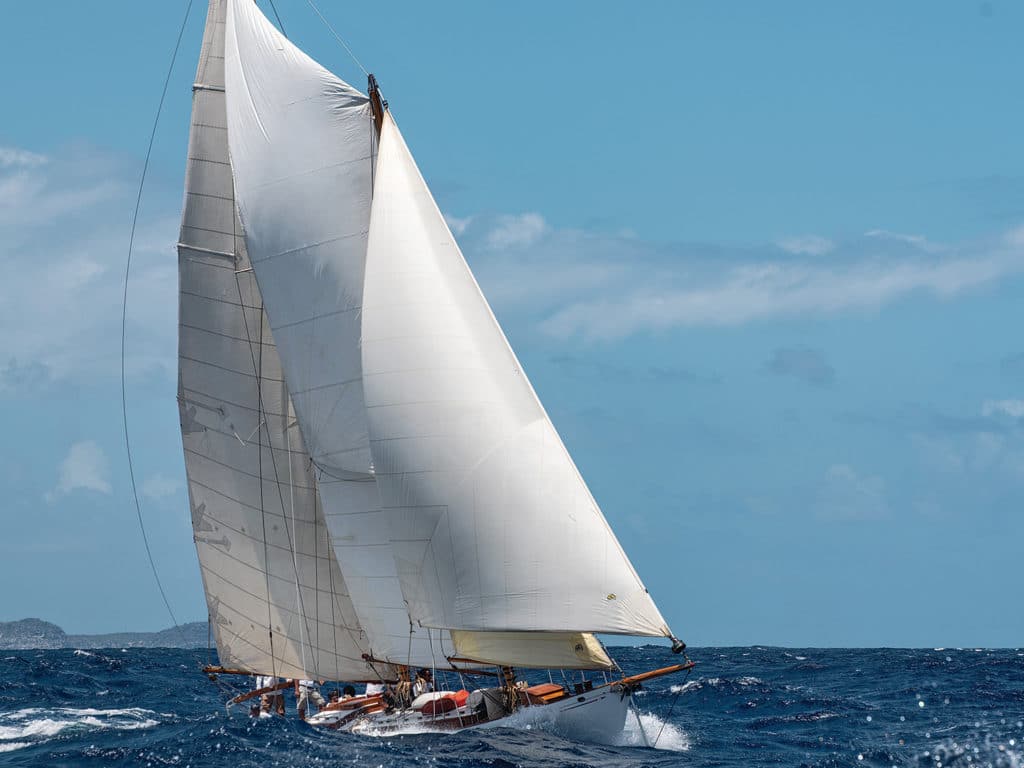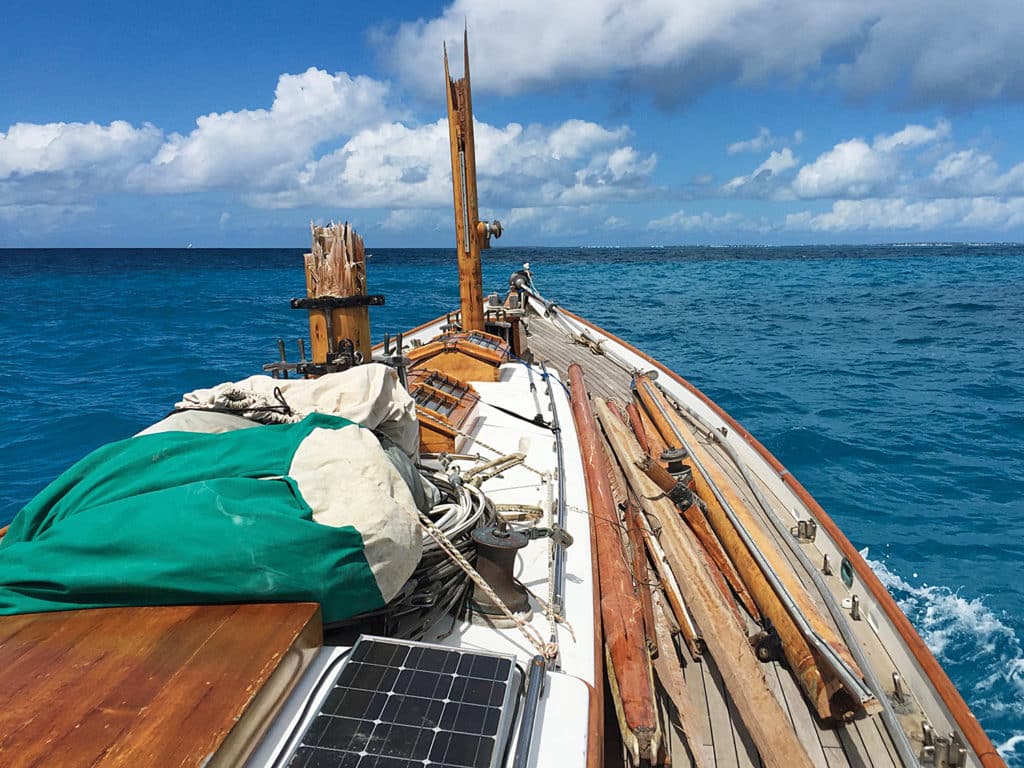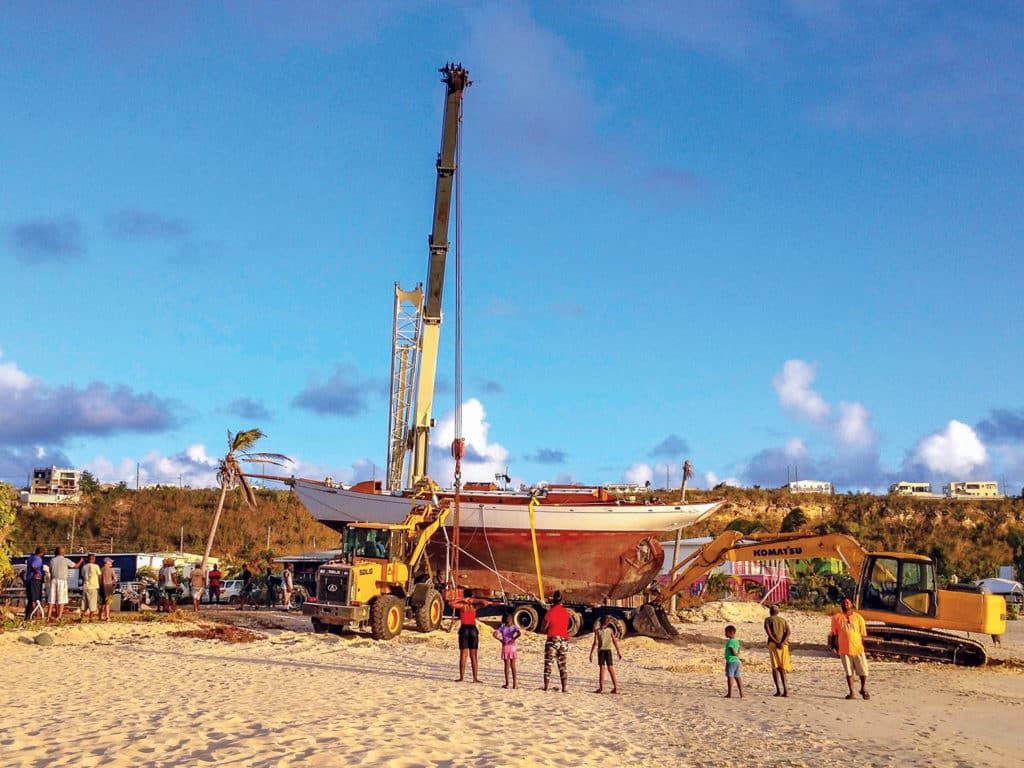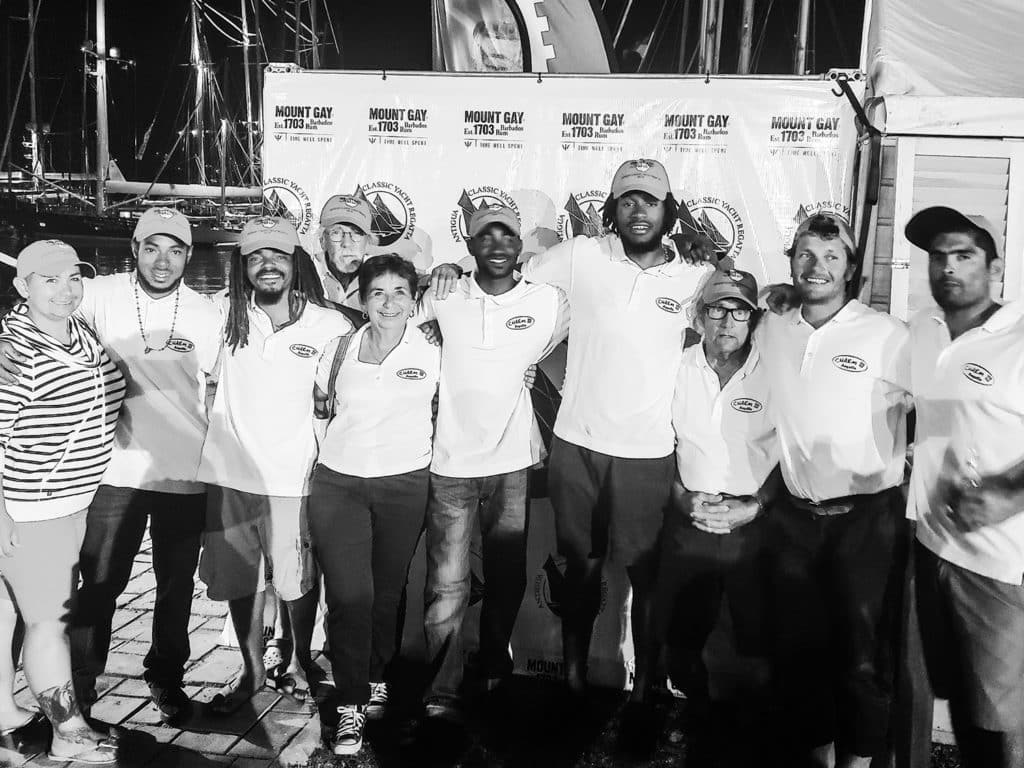
A boat built in 1928 has a lot of history. It has essence. It absorbs a little energy from all who sail aboard, and combines it with the spirit of the ancient trees that ultimately gave it life. It’s—in a word—magical.
Few boats reach legendary status, and the John Alden-designed Malabar schooner, Charm III, is one such boat. Completely rebuilt between 1985 and 2001 on the beach in Anguilla, she is the passion (and perhaps obsession) of owner Richard West, who bought the Swedish-built boat on England’s River Yealm in 1980, and dedicated much time and money to keeping her in fine shape. And, more to the point, keep her racing.
For many classic yachts, especially those based in the Caribbean, the Antigua Classic Yacht Regatta is a must, and so it was for Charm III. But a hurricane had other plans for the boat. In 2017, while Charm III was safely ashore in a St. Maarten boatyard (or so we thought), the island was struck by catastrophic Hurricane Irma. Winds in excess of 150 knots caused islandwide devastation, and fate played a particularly nasty trick on Charm III. Standing strong in her cradle, she bested the storm until the large yacht next to her gave up the fight and toppled onto her. The neighboring yacht took down the schooner’s masts, snapping both, and driving the top of the shattered foremast right through the teak deck.

Extricated from the chaos of the boatyard in February 2018, the 49-foot schooner was motored back to her base in Anguilla, where repairs began.
West flew to the United States and bought a massive trailer. He hired two genius French shipwrights, Tristan Rouff and Aurelio Douay, and in May, using an excavator and a crane, hauled Charm III up the beach and parked her next to his home in Anguilla (as part of the deal, the Frenchmen’s aluminum sloop, Méridien, was also hauled out for work). Sitka spruce was shipped from Alaska to England and then to the island, where two new masts were built. The deck was repaired and refastened, a new rudder built, and the never-ending job of varnishing a classic got underway.
In March 2019, in a reversal of the haulout procedure, Charm III was resplashed. Only this time, the 181-foot, thousand-ton interisland freighter Mutty’s Pride was used to haul Charm III off the trailer into deep water. In retrospect, a possible hard knock during the launch was the cause of the adventure that lay ahead.
With the start of the Antigua Classic Yacht Regatta just four days away, I joined the schooner on her mooring in Sandy Ground, Anguilla. On board were skipper/owner West; Anguillians Kenny Richardson, an experienced sailor, and Devon “Lava” Vanterpool, who had no offshore experience but made up for it with a cracking sense of humor; and Omari “Mari” Carty, who was new to sailing.
On Monday, April 15, we slipped the mooring an hour before sunset and set a course south of St. Barth. Sailing upwind to Antigua in strong trade-wind conditions is never easy; in fact, the island’s upwind location is what made it so valuable to Nelson’s navy in its historic heyday. Laying the rhumb line proved difficult in the heavy, wind-driven seas. Needing the power of her full genoa, staysail and main, Charm III’s lee rail was frequently under as she shouldered aside the combers at 8 knots. The first leaks were a taste of things to come. A romantic might say the old schooner was crying tears of joy to be back at sea, but by the time we reached the coast of St. Eustatius (Statia), her salty tears had turned every bunk and piece of bedding into a sodden mess.
The winds couldn’t have been fouler. Blowing directly from Antigua, they knocked us farther and farther off our course. The decision was made to pass south of Statia and sail down the leeward side of St. Kitts.
A banging below alerted us to the amount of water in the boat. With each leeward roll, water surged up the inside of the hull and lifted one of the floorboards; the banging was the board dropping back into place on the counter-roll to windward. The skipper started the engine, and within minutes the large, engine-driven bilge pump had the water back where it belonged: over the side.

At dawn Tuesday, we beat through the Narrows separating Nevis from St. Kitts, and again were forced from our course by the bullying wind and the North Equatorial Current, driven hard by a mocking full moon. Thoroughly soaked, battered, and unable to cook or serve hot drinks due to a stove malfunction, the crew battled on, with morale remarkably high. Halfway between Antigua and the coast of Nevis, the skipper called for a tack, but it was futile as the wind and seas again drove us back.
Work on the boat in Anguilla had left large amounts of wood shavings and construction debris in the bilge, and though the bilge had been cleaned afterward, the washing-machine conditions dislodged hidden nuggets that continually blocked the strum box—the strainer over the pump’s intake valve. Whichever tack we tried, the cloud hovering over Antigua remained in the same place. At 1600, the skipper furled the genoa, and we began to motor-sail toward our goal.
Then we began to sink.
With a report that the floorboards were almost awash, the strum box was once again hauled from the depths of the bilge. Only this time, it was clear. I took the wheel, and the skipper went below to investigate. His shouts and curses carried above the noise of the wind and seas. The mighty engine-driven bilge pump had been torn from its mountings and was beyond repair.
Fortunately, we had a large hand-operated bilge pump. Unfortunately, it failed after a few strokes, the rebuild kit lying forgotten in storage in Anguilla.
They say nothing moves water faster than a scared man with a bucket, but there is only so much a wet and frightened person can do before fatigue takes over. And of course, the way our luck was going, the handles might come off the buckets. Capt. West admitted that he was considering the last resort: put out a call for help.
To ease the strain on the yacht, we ran off downwind. News from the bucket chain below was they were keeping ahead of the flow, and remarkably, after 20 minutes, they reported that the bilge was almost empty. Our call for assistance was put on hold and, running downwind under reduced sail, at 2200 we rounded the bottom of St. Kitts into calm water, intent on docking at Christophe Harbour Marina. But when no one at the marina answered our repeated calls, we anchored outside, set the watch, ate cold food, and slept.

Where would we be without cellphones and the internet? While the crew slumbered like dead men, the captain’s wife, Maryse, and daughter Mirabelle organized an emergency haulout at the St. Kitts Marine Works on the island’s northwest coast. Dawn on Wednesday saw us jogging north, and by 1100, the boat and crew were ashore in the shadow of historic Brimstone Hill among the dust and wandering goats of the boatyard.
Drying out in the tropical heat, Charm III gave up her secrets. Two seams aft on the port side, low down by the garboard, were open.
Having cleared customs, the skipper went shopping and returned with a massive electric bilge pump, a sheet of plywood, half a dozen boxes of drywall screws and a gallon of roofing tar. Working late into the night, Charm III’s suspect seams were “tingled,” and by 1100 the following day, Thursday, she was back in the water and heading south.
And the leak returned. Not as bad, but bad enough.
Without a doubt, the seams we patched had been letting in water, but in the darkness and the tumbling seas, while cold, wet and hungry, had we missed something obvious? Burrowing under the quarter berth, a mission in itself, Kenny Richardson found the problem. Deep below the engine, which in Charm is fitted backward, the dripless shaft seal was spraying water with every turn of the prop shaft. The bellows keeping pressure on the seals had slipped or lost their tension.
I have a strong stomach and rarely get seasick, but I doubt I could’ve spent three hours head-down under the engine, amid the reek of stale diesel and old boat, to repair that seal. But while Charm III, while hove to, pitched and heaved in short seas, Richardson and Vanterpoole did just that. From down below came cries of “Up the road, skip, up the road!”—which meant we were now Antigua-bound.
Or did it?
The skipper put it to a vote, saying, “Should any man have doubts, we’ll turn north for Anguilla and home.” All voted yay, in favor of Antigua. The last vote fell to me.
“No,” I said, to cries of despair. “First we push the boat hard for four hours and, if all remains well, only then should we set a course for Antigua.”
There were no dissenters. No mutiny.
Four hours of hard sailing became eight; eight became 10. Off the tip of Guadeloupe, we turned north on course for Antigua, and at 0900 on Friday, April 19, dropped anchor in Antigua’s Falmouth Harbour as the fleet of magnificent classic yachts sailed out for the first race.
Waiting in Antigua was the rest of our crew: the skipper’s wife and daughter, the two French shipwrights, and Anguillian Starlin Rosario. Again working into the night, we prepared Charm III for racing, and although we’d missed the first day’s competition, we won the following three to emerge victorious in the Vintage Schooner Class—an achievement made possible by a remarkable boat, skipper and crew.
We flew back to Anguilla and a hero’s welcome led by a throng bearing bottles of champagne and bouquets for each of the crew. Local media gave us celebrity treatment, and a huge sign on the airport road told of the latest exploits of Anguilla’s famous schooner and island crew. As for Charm III, the legendary classic that had just become even more of one, we left her in Antigua having her seams tickled. I only hope the return voyage to Anguilla is a little less hectic. I won’t be making that trip!
Postscript: Shipwrights in Antigua confirmed that the seams we “tingled” had been leaking, probably due to the bump the boat suffered aft when relaunched. However, the leak was only minor, and the main problem was certainly the dripless shaft seal. Replacing the shaft seal on Charm III entails removing the engine, but the above incident, which could have cost us the boat, or worse, proves that the words “fit and forget” have no place in a yachtsman’s vocabulary.
Journalist, photographer and broadcaster Gary Brown resides on the French side of St. Maarten. His books include the action-adventure novels Caribbean High and Caribbean Deep, and the nonfiction work Biscay: Our Ultimate Storm, all of which are available on Amazon.








